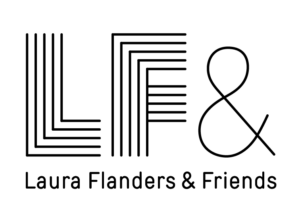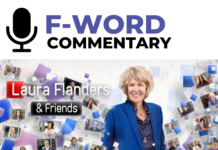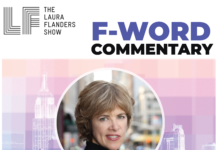The subversive, healing, and celebratory powers of music and media are at the heart of this week’s conversation, featuring Saida Pagán, a contributor to Palabra, a journalism site run by the National Association of Hispanic Journalists, and Dr. Guthrie Ramsey, a music historian, jazz musician and composer recently interviewed on WURD radio in Philadelphia. Pagán shares her take on the new hit movie In the Heights and the progress Latinx media is making in Hollywood; Guthrie reflects on Black joy as expressed through Black music. “Meet the BIPOC Press” is a monthly feature of the Laura Flanders Show. This celebration for Black Music Month is hosted by Sara Lomax-Reese and Mitra Kalita, founder/directors of URL Media, a network of Black and Brown community news outlets that share content and revenue. The panel also addresses concerns about colorism in Latinx movie casting — and more!
“Music, and the arts, has always been a way to express our full humanity and it’s always been our safety valve.” – Dr. Guthrie Ramsey
Guests
- Co-Host S. Mitra Kalita, CEO & Co-Founder, URL Media, CEO & Publisher, Epicenter-NYC
- Co-Host Sara Lomax-Reese, Co-Founder, URL Media, President and CEO, WURD Radio
- Saida Pagán, Contributor, palabra. National Association of Hispanic Journalists
- Dr. Guthrie Ramsey, Professor of Music, University of Pennsylvania, Founder and Editor, Musiqology.com
To listen to the uncut interviews, and to get episode notes for this episode and more, become a Patreon partner here.
Watch this week’s live talk-back with co-host Sara Lomax-Reese and guests Saida Pagán and Dr. Guthrie Ramsey. Join us on YouTube for a live viewing event and chat with Laura and guests Sundays, starting at 11:30am ET.
Prefer to Listen?
Transcript
THE LAURA FLANDERS SHOW
BLACK, LATINX MEDIA: CAUSE FOR CELEBRATION AND CRITIQUE
LAURA FLANDERS: The subversive healing and celebratory powers of music and arts are at the heart of this week’s conversation. The second in our series of Media Round Tables, hosted by Sara Lomax-Reese and Mitra Kalita, co-founder directors of URL Media, a network of black and brown community news outlets. Meet the BIPOC Press is a monthly feature of the Laura Flanders Show with URL. Coming up, some honest talk about the hit movie “In The Heights” and health advice — listen to more music more. I’m Laura Flanders, now over to Sara and Mitra.
SARA LOMAX-REESE: Thanks Laura, this week’s URL Media Round Table is focused on black and brown joy. This is something that we all need way more of in our lives. It’s been a very difficult year. All of us have been navigating the pandemic and systemic racism and all of the things around the election with a white supremacy rearing its very ugly head. And so today we’re going to lean into what URL actually means, Uplift, Respect, and Love. And we’re gonna be joined by two wonderful guests, Saida Pagán, who is a freelance journalist for palabra, which is the National Association of Hispanic Journalists digital publication. And also Dr. Guthrie Ramsey, who is a musician, a composer, a pianist and a professor of music history at the University of Pennsylvania. And both of them are going to be sharing their takes on two important things happening in arts and culture. The release of “In The Heights”, which was a celebration of Latino heritage and culture and Black Music Month, which is the month of June and what that looks like in terms of being an expression for the African-American community to be empowered and to show itself love and community. So why don’t we jump in and Mitra do you wanna kick off the first question?
S. MITRA KALITA: So I wanted to begin with Guthrie on what the role of music has been in expressing joy in the black community?
DR. GUTHRIE RAMSEY: I’m always as a music historian thinking about how black music has worked as one of the primary ways through which African-Americans themselves have viewed themselves as fully human. And even the outside broader culture has recognized the contributions of African-Americans to global musical culture as being one that’s so important. And so when I think about this element of joy that music exudes and passes along, I’m thinking about how, if you have a people who have been marked as inferior, marked as an outsider, yet, you know, building the country, there’s going to have to be some kind of pressure valve. And I always think that artistic expression, whether it’s through visual arts, you know, making pottery or painting paintings, making poems and writing novels, short stories, music. Anything that wherein you can express your full humanity has always been that safety valve. And certainly music has been at the forefront for African-Americans.
SARA LOMAX-REESE: I wanted to just stay on that question that Mitra offered around, what in your scholarship have you seen indicates this broader expression of music as communication, as liberation, as a way to show, not just our full humanity but our creativity and our ability to thrive amidst all of these difficult circumstances.
DR. GUTHRIE RAMSEY: In my research in this history, the first thing I learned is that one of the first sites of interracial interaction was during the Middle Passage, that voyage from in which the enslaved people were taken from the shores of Africa to the New World, there was music making on those ships. So at the same time that the enslaved were able or coerced actually to dance to music and to sing for physical exercise, their oppressors would mark certain women for their singing talent as the ones who would be the first to be raped. Okay, this is all documented. So think about it. The very first context for interracial interaction was something where pain and joy were experienced together. And I would argue that this kind of interplay between pain and joy in music has marked the entire progression of African-American music in the United States and in the New World, in fact. So, if you go to the development of black musical theater, let’s say in the 19th century, it was always about being enslaved and becoming free. So going right to those themes of freedom has always been part of this history.
S. MITRA KALITA: ‘Cause Sara mentioned the reopening, I rode the New York city subway for the first time, which was also an experience where you could just see you know, the street musicians were out and about on each car, there was, you know, people performing. I mean, it was like New York was really feeling back on that subway ride. And the first movie I saw in a theater there was no question of what that movie would be. It was “In The Heights”, which is a movie that kind of to Guthrie’s point, really crystallizes this balance of pain and joy and not necessarily being sure which one you’re experiencing in this immigrant community in Washington Heights. It felt for me like the perfect transition film out of the pandemic, it was truly joyous. Saida, I know you and I have both seen the film. I just wondered, did you have a similar reaction? What did you think of “In The Heights?
SAIDA PAGÁN: Well, I thought it was a wonderful film, it was inspiring. Actually, after the film was over I actually asked some people who had seen it in the audience what they thought and everyone really enjoyed it. You talk about the energy, you talk about realizing your dreams and that’s really what it’s all about.
S. MITRA KALITA: And what is a film like that in terms of representation mean for the Latino community?
SAIDA PAGÁN: Well, I think people obviously want to see themselves on camera. They wanna see their stories told, and it’s been a long long time since we’ve actually seen this. Because this film represents people from the Dominican Republic, Puerto Rico, Cuba, perhaps other parts of Latin America. There were some characters whose backgrounds we did not know for sure. But I think people really enjoy seeing themselves and seeing their stories told.
S. MITRA KALITA: You know, I think the other theme that I picked up on that’s definitely pandemic related was one of reinvention. It just felt like through music and the dancing, you know, I saw New York in a new way, but I also felt like who better than the immigrant to lead us through starting over and coming out of this. Certainly our communities have been hit so hard in the pandemic. And so, you know, I might be assigning a lot of meaning that Lin Manuel Miranda never intended to “In The Heights”, just for our own journey. I’m from the other Heights, Jackson Heights in New York City. But I really did think that this film was symbolic, especially for kind of guiding us out of this moment. It has been received with some controversy. You know, I feel a little sheepish kind of gushing over it because I loved it so and then I come back and start to see criticisms of the film for not being wholly representative of the Latino community. There’ve been accusations of erasure of the Afro Latino community. And I just wondered, Saida, whether you’ve written about that and what you make of that argument as well.
SAIDA PAGÁN: Well, I saw the argument begin online a few days ago and I’ve had a chance to think about it. I am from New York, I am a Puerto Rican background and obviously mixed race myself. I don’t think it was intentional if perhaps they were to have done it over again. They might have perhaps put some or had other stars in there that were perhaps have a little darker complexion to show the, it was an opportunity to show the range of Latinos. Because I saw, I know that the issue is not enough Afro Latinos in the movie. The people who were completely identifiable as of African descent, from what I could see were most likely African-American characters. And it would have been nice to show the range, perhaps have some darker Latinos speaking Spanish so that you would know, or the fact that we all mix, you know, dark and light couple. That would have been something. But I don’t know if that was the intention of the movie. He’s taken note, the producers have taken note of this and in the future I’m sure there’s going to be perhaps a better representation of the complete Latin experience.
DR. GUTHRIE RAMSEY: It’s kind of unfair to me sometimes that like a movie like that would have to bear all of the burden, you know, to represent everything that people feel they need because after all it is a film telling one story in a single way. Now, we can offer our critiques about, well, in order to become a blockbuster, in order to become a very high excelling artist, there are compromises that need to be made along the way. Because generally studios don’t green light things that won’t have that universal appeal. And universal appeal sometimes means changing your story, change, you know, making things simpler, making things, you know, easier to digest. That’s why I love the trend toward more because the more you have the less burden it is on one film to do everything, you know, to show all of the complexities that we want to show. And that goes for musical artists as well, you know. It’s just hard on artists sometimes because actually they didn’t get into that business if they’re an actor or singer or pianist, they didn’t get in that business to represent, you know, something larger than themselves. They got into it because they love to sing or they love to play. They want to bring beauty and value to the world.
SARA LOMAX-REESE: I hear you. And I agree with that. I think that sometimes, you know, there is way too much weight and pressure on a breakthrough kind of film, like what we’re seeing in terms of the controversy around the Afro Latino representation and “In The Heights”. But at the same time, I welcome that critique. I think that it’s valuable to always challenge these things. We don’t need to, you know, become like trolls on Twitter. We don’t need to like, destroy the film, but I think it’s important to raise these questions because for so long these questions around colorism were silent. They weren’t discussed. And so I appreciate the fact that it’s raised. And I appreciate the fact that Lin Manuel Miranda has said, I’m listening. If we’re open to hearing the critique, we don’t have to own it, but if we’re open to hearing it, we might be able to make some different choices going forward. And I appreciate that and I welcome it.
SAIDA PAGÁN: As a Latina with a darker than average complexion, I have been very aware of that in Spanish language television itself, so many of the images are not realistic of what is actually the case, what we really look like. And so I think some of that pressure should be brought upon those who produce the telenovelas, those are the soap, the Spanish soap operas. The news itself, it wasn’t until maybe a few years ago that the Afro Latina anchor woman was hired. So I think the word should get out to many people that we look so many different ways. I just wanted to share that with you, because it’s something that I’ve been wanting to say publicly for a long time, and I think now the time is right.
S. MITRA KALITA: Sara, I’m just wondering, speaking of singing and dancing, URL has been replaying words, songs of freedom from Black Music Month. My Twitter feed is really making me wanna dance when I’m looking at what you all are highlighting there. How are you defining freedom music as you’re doing that? And tell me a little bit about that line of coverage for you guys.
SARA LOMAX-REESE: Songs of freedom, it was really conceptualized as something to dovetail into, again, Juneteenth and the reopening after coronavirus. And in my mind, you know, we’ve got these amazing artists like Nina Simone, “I Wish I Knew How It Would Feel To Be Free”. We talk about Public Enemy, “Fight the Power”. You know, we tried to identify different songs that represent something different to each generation. And, you know, so we have gospel, we have soul, we have funk, you know, jazz. And so just really looking at our incredible range in the black community around songs that are about restoring our humanity, our vitality. And I think that this is a moment where that’s really necessary. But I wanted to, if I could pivot back to Guthrie. You know, we talk about joy, but I think that there’s also something very profoundly healing and restorative about music. Can you talk a little bit about that?
DR. GUTHRIE RAMSEY: Sure. In May of 2019, I was diagnosed with cancer, and as a healthy eater or someone that really focused on health, it was quite a shock. I did what my elders taught me to do and that is to, I started, you know, I planted a garden and started growing tomatoes and I started to record the music that I wanted to heal to. So I arranged some old songs that I had grown up with as a child, some spiritual songs, and I produced an album called “A Spiritual Vibe, Vol. One” and as I was, you know, recuperating from surgery and all of that, I would listen to the music and it just, it really got me together. I’m happy to report that I am cancer-free now. And I believe it was the combination of following the science, but also following that elder ancestors science too. What it would take to heal my body and keep my soul together, keep my mind right and all of that. I just think it’s part of the gift of art music is that it allows us to transport to a safe space, to a healing space.
S. MITRA KALITA: Guthrie, I wanna tell you my father has had two strokes and each time I am convinced it’s music that brings his speech back. And there’s three songs I’m thinking of, or three artists from different cultures in different walks of life. One is anything from KISS in the 1970s is like my father’s coming to America story. The second, which really got through to him, which Saida, maybe you know this song, it’s a merengue song “Dame la Mano Paloma”, which he just associates with those years in Puerto Rico, which for him were like very freewheeling. And then kind of to Guthrie’s point, songs from his boyhood, which are folk songs, that thankfully I can now find on YouTube. And so just through his own recovery, like my family would play these songs and we would, to your point, we would kind of teeter between crying and laughing over everything that they represented. So I just think that’s such a beautiful sentiment of what they can represent in our own healing process.
SARA LOMAX-REESE: Could you talk a little bit about, you know, music as a form of protest and activism and a way that the black community has rallied and communicated with each other to advance our calls for freedom.
DR. GUTHRIE RAMSEY: Protest music, it’s just not always about I’m making a protest song, it’s about a song emerges in the context of strife and it’s gravitated to, so that’s the one thing. There’s also this idea that you can use music and deploy it as resistance. And I’m thinking of the instance of when at the height of the Civil Rights Movement when say the white supremacist cops would roll around and visit the civil rights campaign that was going on in a church, in a black church. And they would be there surveilling. And then when they left, the only way for the community to get back into that frame of mind that they needed to be in is for someone to raise one of those, you know, old folk songs of the church and to get everybody’s mind right. So someone would start singing to kind of clear the air to get everybody’s, you know, head moving back into the right space. So I just think about those two ideas a lot, that some of it is by accident and some of it is quite intentional in its use.
SARA LOMAX-REESE: So this is the question for everyone, but I’m starting with Mitra. What brings you joy right now? What has brought you joy?
S. MITRA KALITA: Well, our newsletter, we actually, because we were launched out of the pandemic, as you said, we were intentional about infusing joy in a really tragic time for our neighborhood. And so our newsletter, it’s literally a feature called “Last Word” and we always feature an artist. And it started with poetry and moved on to visual arts, so a lot of paintings, but, you know, graphics and photography as well. And so in some ways, for me even editing that newsletter which is basically capturing the pain and suffering and ways to help a community every week, like I am guaranteed to end both as the editor and publisher of that as well as the reader on an uplifting note. And that’s really been an important part of our identity. Saida, how about you? What is bringing you joy these days?
SAIDA PAGÁN: I think just the fact that I got through all of this and my family is, you know, okay, safe and healthy. I am now flooded actually with a lot of work, which is wonderful. I do a lot of freelance things in addition to being a contributor for palabra, which is the online publication for the National Association of Hispanic Journalists. I also work as a reporter for the City of Los Angeles and we just won a wonderful award for our work last year. So that’s bringing me joy and just the fact that I’m here and I’m able to do these wonderful things like be the show today.
DR. GUTHRIE RAMSEY: I got to sit down with my mother. Whew, to a plate of red beans and rice about a week ago, after nearly two years of not seeing her. And just to see the joy in her face, you know, through everything that we’ve been through, she’s 93 and she made it through. So that gives me lots of joy.
S. MITRA KALITA: Sara, how about you?
SARA LOMAX-REESE: I think that this process of cultivating present day, present awareness is what’s bringing me joy, because last year, if it taught me anything, it demonstrated how time is a little bit of an illusion. All we have is right here, right now. And if we miss that, then we’re missing everything. So this idea of just opening up and showing up for the right here, right now is bringing me joy.
S. MITRA KALITA: I think that brings us to the right here, right now, which has been a fabulous conversation.
SARA LOMAX-REESE: Thank you, Saida, Guthrie, Mitra, thank you all so much for a very nourishing and joyful conversation. And now to Laura Flanders, for some closing remarks.
LAURA FLANDERS: Black joy, black pain. Well, there was a certain amount of pain at the headquarters of Byron Brown, the four term incumbent African-American mayor of Buffalo, New York, June 22nd, as he watched himself go down to defeat against an activist candidate whom he wouldn’t even debate. But the pain there was nothing in comparison to the joy at team India. That’s India Walton, single mom, nurse, former head of a Community Land Trust. India Walton ran a race that nobody thought she could win, except for the powerful movement groups at her back and some of us in the media. And you wanna talk about what difference media makes? She launched her campaign for mayor on the day our show about her work premiered in her hometown. And she credited seeing herself reflected in our programming, to her community, for giving her some of the courage she needed to run for public office. Media is not just important because it informs people and builds public consciousness. It’s also important because of the way it builds public confidence. When you see yourself reflected in a way that you can recognize, that gives you belief that you’re important, that you can play an important part in the society that you live in, that you matter. That’s why media, like URL Media’s members matter. And that’s why we do this work. So thank you for watching, thanks for your support. Till the next time, stay kind, stay curious, I’m Laura Flanders.
For more on this episode and other forward thinking content and tune into our podcast, visit our website at lauraflanders.org and follow us on social media @TheLFshow.
Want More Art & Media Coverage?
You can find more LF Show coverage here.
Accessibility
The Laura Flanders Show is committed to making our programming, website and social media as accessible as possible to everyone, including those with visual, hearing, cognitive and motor impairments. We’re constantly working towards improving the accessibility of our content to ensure we provide equal access to all. If you would like to request accessibility-related assistance, report any accessibility problems, or request any information in accessible alternative formats, please contact us.
















